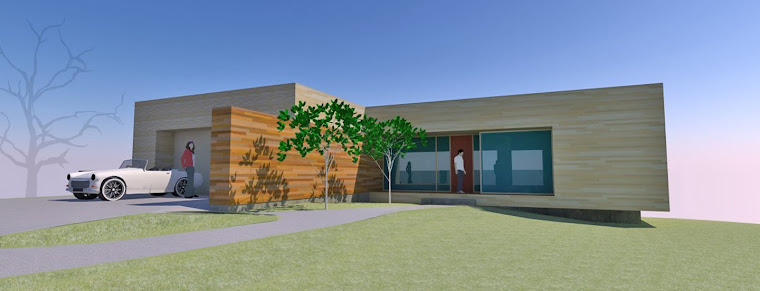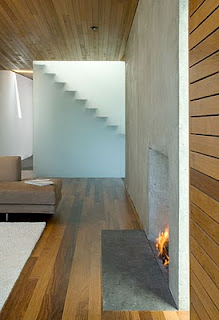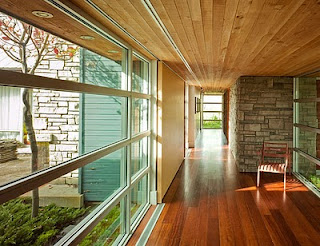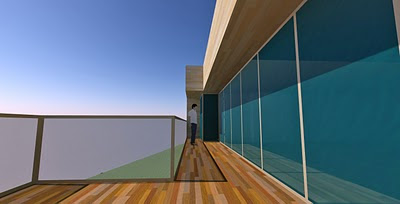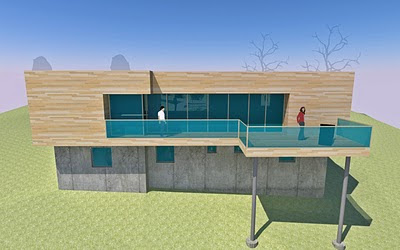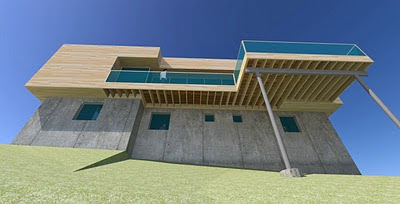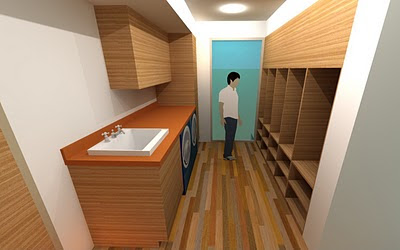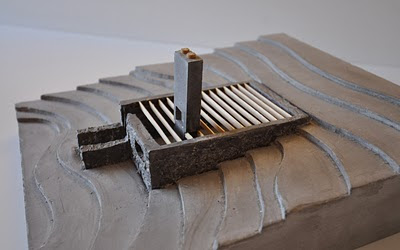The design details and specification of a roofing system can be one of the most important decisions on a project. My project requirements call for low-slope (1/4" per foot to meet code) system that sheds water off the garage, into a scupper system, and landing in a rainwater collection tank.
I will be specifying a single ply roof membrane (Solar Brite by Commercial Innovations / Garland Roofing). Solar Brite is KEE type roofing (Keytone Ethylene Ester) which is much like a PVC membrane roofing in its characteristic and appearance, however its chemical characteristics are an improvement over traditional PVC.
To achieve my monolithic roof slope I plan on a combination of stepped roof structure and tapered polyisocyanurate insulation. All roofing seams will be fully heat welded, with the membrane fully adhered to the polyiso with a water based (i.e. environmentally friendly) bonding adhesive. The insulation will be mechanically fastened to the roof deck. Product specifications will also include pre-molded pipe flashings for roof penetrations, and pre-molded 90 degree inside and outside corners.
I am also thrilled to announce a new partnership for the Little Woods house that will help make the above possible. Garland Roofing (along with their subsidiary Commercial Innovations), and their Dayton territory manager Todd Poeppelmeier, is now on the team. Todd has been a tremendous resource to my commercial clients, and his experience and professionalism will be a terrific asset to this project.
The Garland Company, Inc. is a leading manufacturer and distributor of high-performance roofing solutions. Garland offers sustainable building solutions, as well as maintenance, restoration, and preventive maintenance solutions. Welcome and thank you to Garland Roofing.
http://www.garlandco.com/
June 15, 2011
April 20, 2011
Typical Wall Section
Typical Wall Section showing the structural system, water management system, and thermal system for the house.
Basement Floor = R10
Basement Wall = R20
Exterior Wall = R36
Roof = R55
April 12, 2011
Climate Zone / Recommended R Values
Here is a climate zone map (by county) for the 2004 Supplement to the IECC, the 2006 IECC, and ASHRAE 90.1-2004 for Dayton Ohio, located in Montgomery County. We are in Climate Zone 5.
So per the Building America Special Research Project: High R-Value Enclosures for High Performance Residential Building in All Climate Zones (February 2011) the following are the design recommendations that should exceed the code by at least 2x.
True recommended R values, including thermal bridging:
Wall = 30
Compact Roof = 50
Basement Wall = 15
Slab Edge = 10
Windows (U/SHGC) = 0.24/<.50
Sub-Slab = 7.5
So per the Building America Special Research Project: High R-Value Enclosures for High Performance Residential Building in All Climate Zones (February 2011) the following are the design recommendations that should exceed the code by at least 2x.
True recommended R values, including thermal bridging:
Wall = 30
Compact Roof = 50
Basement Wall = 15
Slab Edge = 10
Windows (U/SHGC) = 0.24/<.50
Sub-Slab = 7.5
March 23, 2011
Wood Veneer
Will be specifying a wood veneer for the first floor higher profile cabinets in the kitchen and living spaces. My wife is from Wenatchee Washington, we met north of Vancouver BC, and I lived and worked in Portland OR. Having spent so much time in the Pacific Northwest, I had the opportunity to fall in love with the lofty douglass fir tree. So as a nod to the PNW, I hope to be using clear vertial grain (CVG) fir veneer.
Will be selecting a laminate compliment at the not-so visable areas like the mudroom, office, etc. Here an are examples of wood grain fake textures by Wilsonart, Nevamar, and Formica, that might work for these areas.
March 21, 2011
More Precedent Images
March 19, 2011
Hemm's Glass
http://www.hemmglass.com/about.php
The little woods house welcomes Hemm's Glass as a project partner. Hemm's glass is located in Piqua, Ohio and has served the Miami Valley region as a family business for nearly 60 years. Rich Hemm will be helping on the design and the installation of the thermally broken aluminum window systems in the house, and I am glad he is on the team.
Windows
I have always loved the clean lines and clear unobstructed views of the aluminum commercial window system. Since aluminum is stronger than wood, window frame thicknesses can be reduced to 2". This seems like the perfect solution for the little woods house. My windows systems are also all 8' tall on the main level, and aluminum can easily span this height without the need for additional reinforcing or thickened frames - allowing for the greatest daylight opening and unobstructed views to the outside. Additionally, i am planning for a large expanse of sliding glass doors between the main living space and the deck. While the nanawall product is cool for certain applications (nanwall lets you slide the complete system away and stacked up against a wall) nanawall doesn't work well in Dayton where you need good insect screens to keep the skeeters out in the summer. I am aware of a large sliding screen product that claims to work for nanawall but is not very practical to manage - especially with little ones around running through screens. Aluminum window systems have large sliding glass door options (think high rise florida condo) that would work perfectly for the application, while also blending seemlessly into the rest of the window systems around the house. Aluminum window systems also offer a thermally broken option, where a gasket is inserted between the exterior and interior frame which greatly reduces thermal conductivity through the window system. 1" thick (1/4 glass plus 1/2" air space plus 1/4" glass) high performance glazing will be specified for the windows, but more on that later.
March 15, 2011
Sustainable Strategies
- Right-size the house - not too big with unused space that we have to pay to build, heat, cool, and pay property tax on.
- Select an infill site (see post on selecting a sustainable site)
- Build the house with community connectivity in mind. The less driving we have to do as a family to work, school, the store and activities will not only make us happier - but will save us on fuel costs over the long run. My commute to work is 7 minutes and we are blocks from the schools - so the kids can easily ride bikes.
- Protect from soil erosion and sediment run-off control during construction. Techniques like using a silt fence.
- Protect green space. I plan on planting a prairie on my 1/3 acre hillside. This should not only look nice - but should keep me from having to mow it (burning fuel and $)
- Maximize open space by building an efficient 2-story house that is compact.
- Stormwater Control. Goal is to have post development run-off be equal to or less than the existing run off. This is achieved through the rainwater collection tank, pervious paving material, and a dry well (if i have to)
- Utilize a cool roof (white or light gray) to cut down on summer solar heat gain through the roof.
- Design the landscaping with indigenous plant material to limit need for excessive irrigation. Use captured rainwater for all remaining exterior irrigation needs.
- Maximize water use reduction inside the house to reduce the burden and $ of Oakwood's municipal water system. In Oakwood, you pay for sewage conveyance tied to water consumption, so reducing consumption is a double bonus. Use of low-flow fixtures and dual flush toilets will help achieve this.
- High efficiency and multiple zoned gas furnace. Variable speed fan motor. Energy recovery ventilator which allows me to pre-heat or pre-cool fresh air with stale air leaving the house. Be able to adjust setting remotely from my iphone. Advanced air filtration for my terrible allergies. Multiple zones will allow for maximum control over zones so as to not heat or cool spaces that we are not using at certain parts of the day.
- On-site renewable energy via solar thermal collectors on roof. Pre-heating hot water so my water heater does not have to work too hard.
- Make house solar PV (solar electric) ready. Add panels in the future when they are cheaper and have a quicker payback.
- Design the house so recycling is easily managed (i.e. close proximity of kitchen to garage where containers will be kept)
- Work to reuse or recycle construction waste and divert from the landfill.
- Select materials with the highest amount of recycled content as my budget allows.
- Specify material that are harvested and manufactured as close to the Dayton region as possible. (no italian marble :)
- Specify materials that are manufactured from rapidly renewable sources.
- Use FSC certified wood (Forest Service Council)
- Specification of low-emitting VOC materials, sealants, and paints.
- Maximize southern exposure or daylighting and views. All occupied spaces will have a direct view to the outside.
- Tell people about the strategies to help further the understanding of the principles, tell the story, partner with like minded companies ...
March 9, 2011
Project Delivery Method
There are as many ways to build a house as there are to skin a cat. The easiest way would be to just hire a General Contractor (GC) and have him responsible for hiring subs that he is comfortable with. The downside of this method is that the GC is going to mark up his subs for his overhead and profit (understandably so since he is assuming the risk and guaranteeing the work of his subs) and passing that along to me in the form of higher construction costs.
Another method is Construction Manager (CM) open book. This method is where a mark-up percentage, (agreed to in advance) is applied by the CM to the various bids from sub contractors. The benefit of this method is that the CM can acquire multiple bids from a minimum of 3 contractors per scope of work, and I get to see all the bids and any savings from the bidding process gets passed back to the owner. This is a pretty attractive route actually...
The method I am considering is acting as the GC myself, and forming strategic partnerships with key contractors who get the vision for the project and want to be part of the team. These partners will get to show-off their talents in their various trades and get the PR benefit of being involved in this project, and hopefully passing along favorable pricing to me. While this process is going to be a lot of hard work, it seems the most rewarding, and has the greatest upside potential of being a fun project to work on, and the most cost effective.
As of now - I am considering the following packages, and am seeking strategic partnerships with companies who do the following.
Another method is Construction Manager (CM) open book. This method is where a mark-up percentage, (agreed to in advance) is applied by the CM to the various bids from sub contractors. The benefit of this method is that the CM can acquire multiple bids from a minimum of 3 contractors per scope of work, and I get to see all the bids and any savings from the bidding process gets passed back to the owner. This is a pretty attractive route actually...
The method I am considering is acting as the GC myself, and forming strategic partnerships with key contractors who get the vision for the project and want to be part of the team. These partners will get to show-off their talents in their various trades and get the PR benefit of being involved in this project, and hopefully passing along favorable pricing to me. While this process is going to be a lot of hard work, it seems the most rewarding, and has the greatest upside potential of being a fun project to work on, and the most cost effective.
As of now - I am considering the following packages, and am seeking strategic partnerships with companies who do the following.
- Landscape Architect
- Civil Engineer
- Landscaping
- Site Clearing / Excavation
- Concrete
- Framing Contractor
- Finish Carpenter (flooring, cabinetry, doors and hardware, metal stair fab, cable rail)
- Drywall Contractor
- Painter
- Plumber
- Appliances
- Mechanical Contractor
- Electrician
- Roofing Contractor
- Theatrical Curtains
- Window Contractor (Hemm's Glass)
- Technology / Security
- Home Audio (may do this myself)
- Rainwater Harvesting
- Solar Thermal (Energy Optimizers USA)
- Garage Door
Schedule
My wife and i bought the lot in 2006, and have been sitting on it for a few years waiting for an end to the endless Great Recession - which has been brutal for those of us whose livelihoods are tied to the construction industry. Design ideas have been marinating in my head for several years while we have stewed about when we were going to be able to build. Right now our schedule is to have the design finished by late fall of 2011, get bids and permits over the winter, and build the house starting in spring of 2012 - with a hopefully substantial completion and move-in target of Christmas 2012.
March 5, 2011
solar studies
I spent some "virtual quality time" on my new back deck this evening taking a looking at how the sun is working with the back overhang - modeled the southern glass exposure to fine tune overhang dimensions. The goal is to set your overhang so you maximize solar radiation through the glass in the winter months, and minimize solar radiation in the summer months. The first model (taken from the deck on the south side of the house and looking west) is at the winter solistice (december 21st at 12:00 noon) when the sun is lowest in the sky. Notice the deep penetration of sunlight into the living space. This helps decrease heating load during the winter months.
This next model is at the equinox (march 21st at 12:00 noon). notice the sun about equidistant between the top and bottom of the glass.
The last model is at the summer solstice (june 21st at 12:00 noon). The sun will never be higher in the sky than at this time. Notice the complete shading of the glass by the overhang.
March 2, 2011
February 28, 2011
February 21, 2011
Concept Floor Plans
Here are the floor plans as they stand today. It is a very tight house - everything we need, nothing we don't. The flow through the house has been careful considered to how we actually live our lives.
February 9, 2011
This is not my house plan!
Thankfully I have the opportunity to design my own house, and if i wasn't an architect i would have probably picked a stock plan like this one. I came accross this plan on one of those internet sites where you can give them your credit card and get plans for your site with a click of the button. Us design types tend to stick our finger down our throats about spec house designs as they ignore the most important design feature (the site) - but i was surprised how this stock plan is very close to my programatic layout i am envisioning for the first floor (Except for the orientation of the garage, the front porch, and i would stick the office where the dining room is shown) - but my contractor can easily make those changes for me, right? :)
Site Orientation
Orientation is everything on siting a house to maximize energy efficiency. The beauty of this site is that the view opens up to the south, exactly how the house wants to open up for maximized southern exposure. The sun is direct from the south, and easiest to control from this orientation as its variation is primarily on the vertical axis. Eastern and western exposures are much harder to control as the sun is moving wildly in these exposures during the day and across the seasons. The maximized southern exposure should provide ample opportunity to heat up the thermal mass of my basement walls, helping to keep the house warm in the winter. Additionally, i have a close neighbor to the east, and for privacy would rather not be very exposed in this direction.
Design Precedent
"Precedent" is simply a design term used by architects to describe a project example in the past that has influence over your design solution. My main precedent takes me back to my days in architecture school. The first model I ever built was of the Chamberlain Cottage, designed by Walter Gropius and Marcel Breuer in Wayland, MA in 1940. I built the model base our of hydrocal plaster, and the wood cottage out of basswood. The project is a hauntingly simple wood box, sitting (and cantilivered at one end) on top of a solid masonry base. I have always been compelled by the visually ligthness of the wood box floating on top of the visual weight and solidity of the base. The site of the Chamberlain Cottage is sloping to an exterior view, similar to mine. Here are some photos of my model (that is now 20 years old), as well as some images of the Chamberlain Cottage.
January 27, 2011
Soil Borings
As part of my due diligence I had 4 soil borings dug and tested by Bowser Morner, a local reputable soils engineering company. Soil borings are critical to verify proper compaction of soil, levels of ground water level, and will provide data for my structural engineer to design foundations and slabs on grade.
Site Survey
I had an as-built topo and utility survey created for the site, and created in AutoCad for use in my house design. I requested the surveyor spot trees and show diameters, as saving trees will be important wherever possible. The area shown in yellow represents the buildable zone, with all City approved setbacks shown. The beauty of this site, compared to the other sites created in the developement is that the building area is closest to the cul-de-sac. Reduced distance to the street is directly proportional to reduced development cost, as site utility extensions, and lineal feet of paved driveway can be reduced.
Subscribe to:
Posts (Atom)
